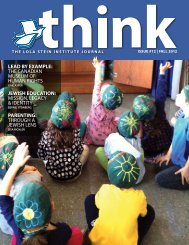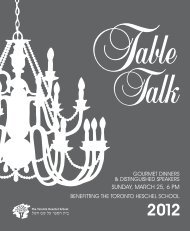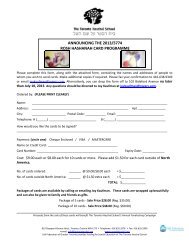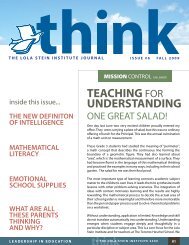Issue No. 13 - The Toronto Heschel School
Issue No. 13 - The Toronto Heschel School
Issue No. 13 - The Toronto Heschel School
Create successful ePaper yourself
Turn your PDF publications into a flip-book with our unique Google optimized e-Paper software.
BOOK REVIEW<br />
BEYOND<br />
COURAGE:<br />
THE UNTOLD STORY OF JEWISH RESISTANCE DURINGTHE<br />
HOLOCAUST | by Doreen Rappaport<br />
<strong>The</strong> story of the Holocaust is of ultimate importance; yet if six<br />
million books were to be written on the Holocaust, it would still<br />
remain for myriads of other volumes to explain the event and<br />
plumb its depths for insight into the human condition and the<br />
Jewish condition. <strong>The</strong> way we tell the story is also of significance.<br />
First, there was silence. Perhaps the horror was most appropriately<br />
conveyed in the mute roar of its survivors. Once the narrative entered<br />
the word, it was necessarily constricted, but also transmissible.<br />
Anne Frank’s Diary, published in Dutch in 1947 and in English in<br />
1952, told of the terror leading up to the extermination, but not<br />
the event itself. Elie Wiesel’s Night – first published in Yiddish barely<br />
10 years after the liberation, then in French, then in English – was<br />
the groundbreaking literary introduction of eyewitness to the<br />
flames of extermination. Over a half century later, the blurb on<br />
the back of a paperback edition still does it justice: “a slim volume<br />
of terrifying power.” Two decades later, Gerald Green’s novel and<br />
groundbreaking TV series Holocaust brought the topic to the<br />
A book review for think by Rabbi Joe Kanofsky, Ph.D.<br />
masses; a generation later, the film Schindler’s List extended its<br />
reach.<br />
Often, the literature slips over and renders invisible the<br />
countless moments of spiritual resistance and defiant<br />
humanity that endured at the edge of the abyss.<br />
Through the tens of thousands of volumes of analysis, eyewitness,<br />
and scholarship published to date about the Holocaust, certain<br />
perspectives endure. That the Jewish victims went “as sheep to<br />
slaughter” remains a persistent trope. Often, the literature slips<br />
over and renders invisible the countless moments of spiritual<br />
resistance and defiant humanity that endured at the edge of the<br />
abyss. <strong>The</strong> origins of this reading of Holocaust victimhood could<br />
lie in early Israeli attempts to grapple with the national tragedy;<br />
casting Shoah victims as powerless may have been a move to<br />
highlight the contrast between exile and Israeli, victim and selfdefender,<br />
Old Jew and New Jew.<br />
Doreen Rappaport’s Beyond Courage aims to tell the story of some<br />
of this resistance to a young teen audience in a way that promises<br />
to supplant the “passive and subservient victim” narrative with a<br />
much more muscular view of Jewish action in confronting the tide<br />
of extermination. For this we owe Rappaport a debt of gratitude;<br />
she recasts the Holocaust experience for those who are familiar<br />
only with the trains and gas chambers portion of the story.<br />
To be sure, the substance of the book, in documenting acts<br />
of sabotage or mostly armed resistance by Jews against the<br />
Nazi onslaught in the ghettos, in the camps, and as partisans<br />
accomplishes its goal. <strong>The</strong> gripping and enthralling tales of<br />
sabotage, escape, reprisal, and uprising depart radically from<br />
victimhood. <strong>The</strong>y portray Jews as seizing their own destiny, insofar<br />
as it was possible, and resisting to the last the Nazi strategy of<br />
dehumanization and disempowerment. In fact, in the pages<br />
of this book, Jews shed the role of passive victims, in which the<br />
intervening decades have cast them, and are now seen in many<br />
dimensions, beyond numbing statistics and grim faces peering out<br />
from the cattle cars.<br />
<strong>The</strong> efforts to move children out of occupied Europe by clandestine<br />
or other means are documented; as are the Bielski Partisan troupe<br />
portrayed in the film Defiance; and the smugglers, later the fighters<br />
and leaders of ŻOB, the Żydowska Organizacja Bojowa, the Jewish<br />
Combat Group of the uprising in the Warsaw ghetto. Here too<br />
are the authors of Vedem, the children’s<br />
underground artistic and literary magazine<br />
in the <strong>The</strong>resienstadt ghetto; Abba Kovner<br />
and Vitka Kempner of the Vilna Partisans;<br />
and escapees from the <strong>No</strong>vogrodek labour<br />
camp in Byelorussia. In the death camps we<br />
now see the sonderkommando uprising<br />
in Auschwitz and the Sukkot escape from<br />
Sobibor. All these give depth and dimension<br />
in rounding out the “untold story of Jewish<br />
Resistance during the Holocaust,” as per the<br />
book’s subtitle.<br />
In the pages of this book, Jews shed<br />
the role of passive victims.<br />
As a series of compelling tales of refusal<br />
to accept victim status, the narration<br />
provides enough detail to remain<br />
engaging, and the length of each holds<br />
the reader’s interest. <strong>The</strong> teenage or young adult reader might be<br />
left to wonder what motivated some to resist and others to follow<br />
instructions; some to jump from the moving trains and take flight<br />
in the ghetto sewers and others not to try. This raises the larger<br />
question of what resistance entails: is it only demolition of bridges<br />
and smuggling children, or can it also be teaching Torah in the<br />
ghetto, or singing Shabbat zemirot in Dachau? This is a question<br />
for adults as well as younger readers to ponder.<br />
<strong>The</strong> best historical nonfiction can transport the reader back to the<br />
time and place of the subject matter; as awful as it is to imagine<br />
oneself in the kingdom of night, Beyond Courage offers the reader<br />
the chance to think about what bravery, heroism, humanity, and<br />
determination might mean in a world where the guiding lights<br />
of morality, order, and decency seemed by all accounts to have<br />
been extinguished. What can it be, the reader might ask, that gives<br />
one a moral compass when morality seems to be at best inverted,<br />
or at worst vanished from the face of the earth? What was it in<br />
the formative years, the culture, or the beliefs of those Jews who<br />
resisted, that motivated them to step off the conveyor belt of the<br />
death factories and grapple with their tormentors?<br />
As with any survey, one can always wish for a broader scope: there<br />
are almost no images of identifiably religious Jews. In fact, of the<br />
handful in the book, one depicts Jews in religious garb “humiliated,”<br />
three wearing swastikas daubed on their clothing and two wearing<br />
tzitzit unnaturally; the other shows Jews in talit and tefillin and is<br />
accompanied by the note that the photo “may have been staged.”<br />
Unfortunately, the images of religious observance here for the most<br />
part only resonate with derision and mockery, not with heroism.<br />
<strong>The</strong> paucity of images of visibly religious Jews might imply that<br />
physical, armed resistance is qualitatively different than spiritual<br />
resistance.<br />
It offers us a chance to think about what bravery,<br />
heroism, humanity, and determination might<br />
mean in a world without morality,<br />
order, and decency.<br />
That notwithstanding, Rappaport<br />
performs an important task in showing<br />
a side of the Holocaust experience that<br />
had much more to do with creativity,<br />
innovation, determination, and will than<br />
victimhood. <strong>The</strong> question of “passivity”<br />
of those who went to their deaths is not<br />
one to be conclusively answered, and to<br />
pronounce that judgment on those who<br />
can no longer speak for their decisions is<br />
unfair. Still, this volume is an important<br />
addition to the Shoah curriculum, and<br />
deserves praise as it opens new avenues of<br />
understanding and hopefully new avenues<br />
of inquiry about the Shoah.<br />
Rabbi Joe Kanofsky, Ph.D., earned a Doctorate in Comparative<br />
Literature from Boston University. He was ordained at the Rabbinical<br />
College of America where he was a Wexner Fellow. From 2001-2004<br />
he was Director of the Ronald S. Lauder Foundation in Poland and<br />
currently serve as Rabbi of Kehillat Shaarei Torah in <strong>Toronto</strong>.<br />
20 think • issue <strong>13</strong> • SUMMER 20<strong>13</strong><br />
21






